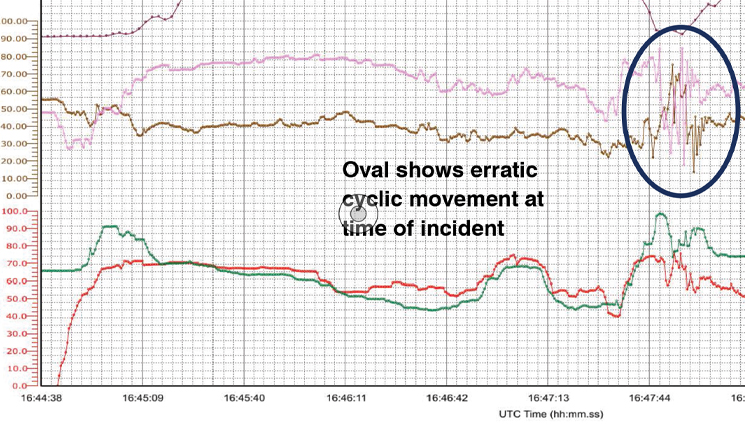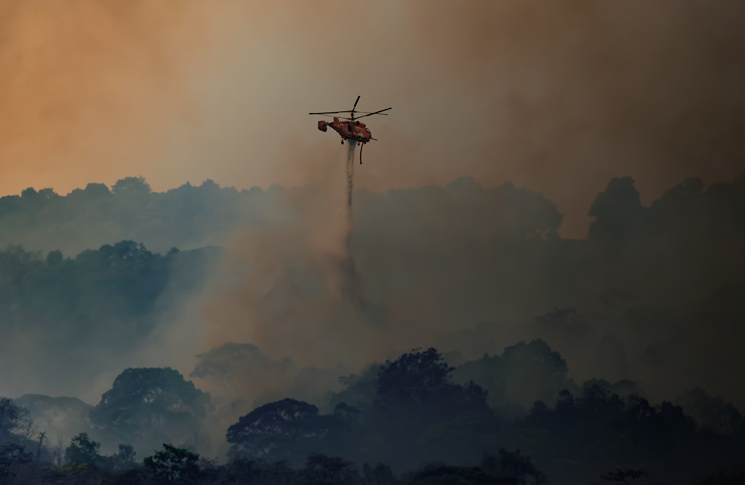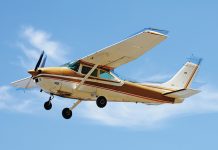Flying near a fire can result in the pilot losing the visual cues needed to stabilise the helicopter
As we move into summer, the nation’s aerial firefighting aircraft are preparing for another fire season. These aircraft have great capabilities; however, the task isn’t without risk.
Here we analyse an incident in California involving an AW139 that was conducting firefighting with a purpose-built belly tank. The aircraft had made several successful passes when it was called to another fire that was threatening a house.
The aircraft conducted reconnaissance and then proceeded for the drop. This required a descent and deceleration to the drop speed of less than 40 knots. As the aircraft levelled, the pilot required power up to 110 per cent torque; however, the low-rotor horn sounded and the pilot couldn’t stop the aircraft descending.
There was a tail wind and the helicopter probably decelerated below effective translational lift (ETL). The pilot jettisoned the water load to improve performance but the aircraft yaw could not be controlled – loss of tail rotor effectiveness (LTE). While slowly turning, the helicopter descended into the trees, damaging the rotor blades, fuselage and empennage.
However, the pilot managed to fly the aircraft away and conducted an emergency landing at a nearby school oval. Was this a simple case of underestimating the power requirements in local high-density altitude caused by the fire?
The NTSB report discussed the increased challenges of getting close to large fires.
The National Transport Safety Bureau (NTSB) investigation discussed the unique conditions from the smoke plume that contributed to this incident. The incident site density altitude was 3100 feet and there was a tailwind. Depending on the terrain, pilots need to apply some form of power margin for low-level operations or have readily accessible escape options to make it to lower ground. If you are firefighting at low speeds without an ability to turn into lower ground, then a margin above out of ground effect (OGE) power, once the load has been jettisoned, would be wise.
In this case, the pilot conducted a precautionary load jettison as the incident was developing. This did not stop the helicopter settling into the trees but avoided the loss of the aircraft.
The NTSB report discussed the increased challenges of getting close to large fires: reduced visibility, turbulence, hot temperatures with decreased aircraft performance and increased power requirements, actual heat damage to the aircraft and flying debris lifted by the hot air. Specific advice about ‘Smoke column hazards’ was published in March 2018 in a US GovernmentInteragency Aviation Accident Prevention Bulletin.
If you are getting close to a fire, would it be wise to carry an increased power margin? Do you need better than OGE power, even before you jettison the water load? In this case, getting below ETL and having a tailwind suggests this may have been the best option. However, there are many variables at a fire site, so this may be hard to pre-plan.
Another possible contributing factor in this incident that isn’t discussed could be the low visual cues available. Being close to the ground below ridgelines and near or even in smoke reduces the visual cues that are available to pilot the aircraft. Small changes in aircraft attitude will be more difficult to notice until they become large.
Many pilots can operate near LTE in a good visual cue environment because they can quickly pick up the small yaw movements and can stop uncontrollable yaw rates developing. However, if you are slow anticipating because you can’t see enough cues, then a yaw rate may start to develop and, if pedal application is slow (again because you can’t see), LTE may occur.
The flight recorder data analysis shows some interesting plots. The aircraft attitude during the incident reached 33 degrees nose up. The AW139 has an automatic flight control system (AFCS) that is designed to help the pilot reduce workload, especially in poor visual cue environments. Functions such as the short-term stability augmentation system and attitude hold help keep the aircraft stable when the pilot can’t see the usual range of attitude and heading cues.
In this case, the extreme attitudes reached may have been partially a result of poor AFCS use. Looking through the flight recorder data, this seems to be the case. The aircraft attitude hold function had been turned off. This was likely an attempt to reduce the workload, of retrimming the cyclic as airspeed changed in the low-level environment.
Approaching a low visual cue environment requires slow precise flying and setting up the autopilot so there is little requirement for large trim applications.

You may get away with turning attitude hold off in a very good visual environment; however, once you enter a reduced cue environment, the use of attitude mode decreases your workload. Arguably, being in smoke below the ridge lines is a reduced cue environment. Referring to the data traces, the report suggests classic low-speed, unusual attitude behaviour, ‘The longitudinal and lateral cyclic tracks show large and uncoordinated inputs for at least 10–12 seconds, while the aircraft was flying above the mentioned residential complex, with backwards ground speed between 8 and 26 kts.’
This seems to indicate that the incident was more than just settling into the trees due to a localised high-density altitude, as discussed earlier. If the pilot had entered this situation in attitude mode and used the trim functions correctly, the propensity for the aircraft to oscillate erratically would have been reduced. This sort of aircraft behaviour is characteristic of not having attitude mode engaged or utilising the force trim release excessively in a reduced visual cue environment.
Approaching a low visual cue environment requires slow precise flying and setting up the autopilot so there is little requirement for large trim applications. Small changes can then be made to guide the aircraft, using small trim changes or small forces on the cyclic – this keeps the attitude hold functions working.
The incident has several contributing factors: lack of anticipation with pedal when increasing collective, tail wind and failure to allow sufficient power margin for the environment, which can be a superheated turbulent airmass from the proximate fires. However, there is probably another contributing factor that isn’t specifically mentioned – inappropriate AFCS use for a reduced visual cueing environment. Reduced visual cueing environments aren’t just on very dark nights – they can occur on bright nights with low contrast and even by day in some cases.
The aim of firefighting is to reduce the threat and preserve life and property. Operating your aircraft within its limits and your personal limits for the specific environment will ensure you don’t end up being out of the frying pan – and into the fire.





